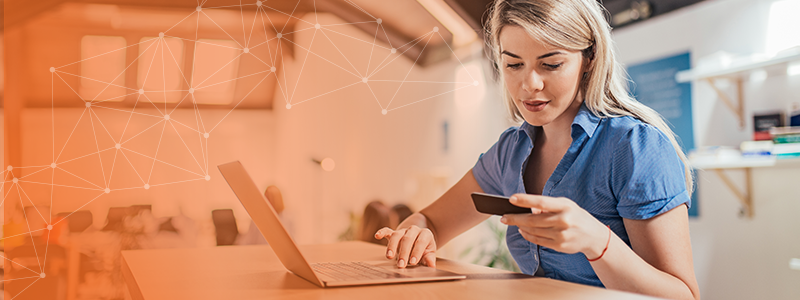
In the SOTI Report “From ‘Bricks to Clicks’: Navigating the Retail Revolution”, consumers made it clear that mobile technology is the key to delivering shopping experiences that deliver the “three C’s”:
-
Customized: 76% of shoppers want their mobile devices to deliver a personalized, in-store experience.
-
Convenient: 67% of consumers believe retailers who utilize mobile technology provide a faster shopping experience.
-
Contactless: 66% of shoppers don’t want to interact with store associates and 77% of shoppers would shop in stores where only self-checkout was offered.
The desire for tailored shopping extends beyond the store. From the State of Mobility in Retail Report, 90% of shoppers are happy with one or more delivery options outside of in-store transactions, such as autonomous vehicles and drones.
How Mobile Technology is Changing the Retail Landscape
The distinction between online and in-store shopping has changed; consumers prefer technology-enabled shopping experiences. What was once limited to the retail floor can now be found online, and online integrations are becoming staples throughout the in-store shopper experience.
What remains constant is that shoppers continually demand high quality products and services, at the best possible price, as quickly as they can get it.
Consumers demand experiences that suit their needs and they’ll shop where they can get it. Retailers must embrace this omnichannel trend and leverage mobile technology and the Internet of Things (IoT) throughout the entire supply chain, in order to deliver that experience.
Here are some ways mobile technology is changing the industry for both retailers and shoppers:
-
Better shopper experiences: It sounds contradictory, but once a shopper enters a store, helping them to find what they want and checking out as quickly as possible is the key to successful retail. Interactive mobile technology like kiosks, beacons and sensors direct them to the products they are looking for while digital signage gives them all the relevant information about it.
-
Streamlining operations: Retailers are equipping warehouse workers and store associates with mobile devices like barcode scanners or radio-frequency identification (RFID) readers. Meanwhile, Electronic Logging Devices (ELDs) and trailer tracking and tracing systems provide real-time visibility into critical aspects of a supply chain, significantly reducing the number of unexpected delays.
-
Stock awareness: A prime example of a retail disaster is when a shopper searches for a product online and sees it is in stock at a store nearby. They go to the store and ask for the item only to be told that the website was wrong, and the product is out-of-stock. Modern retailers see inventory discrepancies by as much as 25%.1 Mobile technology gives retailers and shoppers an accurate count of available product quantities, ensuring a positive shopping experience.
Want to know more about how mobile technology enhances the retail experience for retailers and shoppers? Check out this helpful infographic:

Predicting Future Retail Mobility Trends
The ongoing COVID-19 pandemic continues to shutter many non-essential retail businesses with devastating results. European retailers are expected to lose roughly £3.6 billion2 (approximately $5.6 billion CAD and $4 billion USD). Meanwhile, 53% of U.S. shoppers say they will avoid visiting stores altogether because of the coronavirus.3
But when those shoppers return, they will expect their favourite retailers to deliver the customized, convenient, and contactless experience mentioned earlier in this blog post.
And here is how they will do it.
Line Busting
Let us line up some stats about lining up, shall we:
-
The average shopper thinks approximately 8 minutes is the maximum acceptable time to wait in line.4
-
86% of consumers have left a store due to frustration about long wait times in line.5
-
U.S. retailers lose an annual average of $38 billion in potential sales due to shoppers leaving empty-handed.6
Shoppers will be rushing to visit their favourite retailers after COVID-19 restrictions are lifted but they won’t enjoy waiting in line to pay for their purchases.
Line busting is exactly what it sounds like: Shortening or eliminating lines by allowing shoppers to pay away from the main checkout. And with mobile technology, line busting can take many forms:
-
Roving handheld scanners: Associates throughout the store are armed with handheld scanners. When a shopper with a small purchase is ready to checkout, the associate scans the item and the shopper pays on the spot without the need to wait in line.
-
Scan-as-you-shop: Already popular in Sweden, shoppers can scan items via an app as they shop. When the shopper is finished shopping, the app has already calculated the total cost of their scanned items. The shopper pays directly from their smartphone, bypassing the checkout line.
-
Pre-order, pre-pay: This type of line busting technology can be found in restaurants and is making its way into retail stores. Shoppers use tablets mounted on kiosks to place an order and pay for it. Store associates then bring the order directly to the shopper.
Buy Online, Pick-Up in Store (BOPIS)
The typical scenario when a shopper makes an online purchase is that their goods are shipped to them. If a shopper makes an in-store purchase, they instantly bring their items home with them.
Now, there is a third option which 70% of U.S. shoppers7 and 50% of Canadian shoppers8 have already utilized: Buy online, pick-up in store (BOPIS).
There are many reasons why shoppers demand an omnichannel experience:
-
Delivery is difficult: Delivery costs are too high (as they are for 48% of U.S. BOPIS users), delivery time is too long (39%), or the delivery window is too inconvenient (28%)9.
-
Product control: Although the product was purchased online, 77% of shoppers want to see it and touch it before taking it home. If the item is not what they want or thought it would be, 23% like the choice of being able to return it right away.10
By 2021, 90% of retailers plan to implement BOPIS and 37% believe that once a shopper arrives to pick up their order, they will make additional in-store purchases.11
There are many ways mobile technology helps with BOPIS. For example, mobile devices can be used for transportation and logistics tracking of products being shipped from a warehouse or distribution center to the pick-up location. Customized apps allow shoppers to check-in when they have arrived in order to retrieve their purchase. Those same apps can also provide upsell recommendations based on the BOPIS purchase and help the shopper find their way around the store to those products.
Retail Robotics
Robots can already be found on warehouse floors and distribution centers as they pack, scan and transport inventory. Meanwhile, it is expected that robotic or autonomous vehicles will make up 85% of purchase deliveries by 2025.12
Now robots are making their way into retail locations to help improve the shopping experience from the moment shoppers' step inside.
Entering the store
- Robots greet shoppers as they enter the store and display any promotional items or discounts. A shopper asks the robot where they can find a certain item, and the display then changes to a map with easy-to-follow directions.
Shopping and browsing
-
In large stores, shoppers can ask a robot where something is, and the robot will lead them to it. As robots make their rounds, they can scan shelves and automatically inform backroom associates when inventory is running low. Maintenance robots can sweep, wash and dry floors to ensure store cleanliness.
-
Using facial recognition technology, robots can determine if a shopper appears to need help and send a message to a store associate who can then provide assistance.
Checking out
- Eventually, robots will be able to take care of the line busting duties mentioned earlier in this blog. When shoppers are ready to pay, they will find the nearest robot, have it scan their purchase (and loyalty card) and pay accordingly.
How SOTI Helps with Retail Mobility Management
The seven revolutionary product in the SOTI ONE Platform enable retailers to better serve their shoppers in a variety of ways.
SOTI Snap lets retailers build custom apps which eliminate pen-and-paper based processes such as collecting customer information. With SOTI MobiControl, devices such as smartphones, tablets, kiosks and scanners can be deployed quickly into the hands of store associates. SOTI Assist remotely diagnoses, troubleshoots and resolves any mobile tech issues that retail store, or warehouse staff are dealing with. And SOTI Connect allows retailers to take control of IoT connected devices such as mobile printers.
Check out the following resources
- View customer success stories featuring retailers from all over the world
- Read the Technology Spurs Shopper-Centric Retail and Make Every Day a Cyber-Monday eBooks
We want to hear from you
- Let’s talk about how the SOTI ONE Platform can help your retail business
- Request a demo of the SOTI ONE Platform
- Start your FREE 30-day trial of the SOTI ONE Platform
- Retail Touchpoints, 6 Ways to Thrive in the Changing Retail Landscape
- Statista, Coronavirus Impact of Lost Retail Sales in Europe 2020
- Statista, Likelihood of Consumers to Avoid In-Store Shopping Because of COVID-19 in the U.S.
- Parcel Pending, Retailers Losing Billions in Revenue Due to Long Lines
- Parcel Pending, Retailers Losing Billions in Revenue Due to Long Lines
- Parcel Pending, Retailers Losing Billions in Revenue Due to Long Lines
- Digital Commerce 360, BOPIS is the Next Wave of eCommerce
- Square, BOPIS Might Be the Thing You Need
- Business Insider, US Consumers Use Buy Online Pick-Up in Store
- Invesp, Buy Online Pick-Up In Store – Statistics and Trends
- Invesp, Buy Online Pick-Up In Store – Statistics and Trends
- Robotics Business Review, Robotics in Retail Key to Industry, Market Transformation



